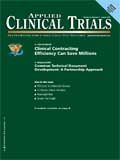In Pursuit of Enlightenment
Applied Clinical Trials
Knowledge is power, but power is of no value if you don't exercise it.
A consistent theme that I hear from clinical study teams is the desire to have greater visibility and insight into clinical trials. Whether it's the status of site activation, overall patient recruitment, or some other view of important trial data, study teams are desperately trying to find the path to this intelligence.

I was reminded of this theme when I attended a clinical outsourcing conference in London earlier this year where sponsors, CROs, and other members of the clinical trial community discussed the challenges and approaches related to strategic outsourcing. All the conversations showed that the foundational elements of transparency—trust and collaboration—are seen as critical elements of a successful outsourcing relationship.
Related to this, a recent Gartner report by Steven Lefebure summarized the results of a clinical study best practices survey and identified "real-time visibility" as one of the best practices. Forty-five percent of survey respondents rated "near real-time line-of-site visibility to all trial activity" as highly effective in trial execution, analysis, and submission. Based on additional findings, Gartner also concluded that simply "having additional data, in and of itself, is not sufficient to achieve value. The information must be acted on."
Knowledge is power, but power is of no value if you don't exercise it. In order to do that, you need to be able to analyze information and draw conclusions to make the best decisions and take appropriate action. So, how do you get away from the mess of paper that for example, is involved in clinical study management, to a state of empowered enlightenment?
As a first step, think about the end goal and work backwards. In order to take action, teams need access to data that will allow them to analyze situations and make decisions. This, in turn, is reliant on visibility into real-time process status. Finally, in order to have visibility, the process needs to be centralized and standardized to enable a comprehensive view.
Simply stated, the roadmap to success is: centralize, standardize, automate, monitor, and act.
These tenets are not new, but change is difficult. Just think how long it took for EDC to be widely adopted. eClinical abilities, however, now need to extend beyond capturing data to capturing the whole process. Think about the mountains of physical paper exchanged between sponsors and sites for a single study. Although the prospect of centralizing this activity for all global studies is daunting, the technology exists to do it. Web-based, or cloud computing, solutions are literally changing the way business gets done.
Available 24/7/365 via an internet connection, cloud solutions are breaking down the barriers of technology adoption and time zones. Companies are now able to centralize business processes online via secure, controlled document exchange, workflow, and collaboration. What was once manual, paper-based, and "untrackable" becomes centralized, standardized, and automated, allowing for real-time monitoring. Clinical teams can gauge the status of a process, such as how many sites have been activated for a new trial, who has received and reviewed information about a serious adverse event, or who has outstanding tasks that need to be completed. This new insight empowers study teams to take action to ensure milestones are hit, resulting in faster, smarter clinical trials.
Enlightenment is ours for the taking.
Linda Bowers Vice President of Life Sciences Product Marketing IntraLinks [email protected]

Improving Relationships and Diversifying the Site Selection Process
April 17th 2025In this episode of the Applied Clinical Trials Podcast, Liz Beatty, co-founder and chief strategy officer, Inato, discusses a number of topics around site engagement including community-based sites, the role of technology in improving site/sponsor relationships, how increased operational costs are impacting the industry, and more.